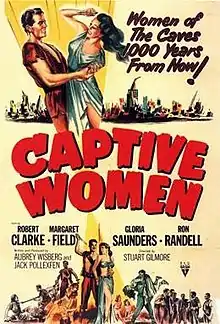Captive Women
Captive Women is a 1952 American black-and-white post-apocalyptic science-fiction film. It stars Robert Clarke and Margaret Field. The film has a running time of 64 minutes. It deals with the effects of a nuclear war and how life would be afterwards.
| Captive Women | |
|---|---|
 | |
| Directed by | Stuart Gilmore |
| Produced by | Jack Pollexfen Aubrey Wisberg |
| Written by | Jack Pollexfen Aubrey Wisberg |
| Starring | Robert Clarke Ron Randell Margaret Field Gloria Saunders |
| Music by | Charles Koff |
| Cinematography | Paul Ivano |
| Edited by | Fred R. Feitshans Jr. |
Production company | Albert Zugsmith Productions |
| Distributed by | RKO Radio Pictures Inc. |
Release date |
|
Running time | 64 minutes |
| Country | United States |
| Language | English |
| Budget | $85,000[2] |
In the United Kingdom the film is known as 3000 A.D., the film's original title. [3]
Plot
The film opens with war footage from a World War III ending with a nuclear attack
Long after the nuclear war, the last human survivors are divided into three tribes. Robert (Clarke) and Ruth (Field) are about to be married in the ruins of a post-apocalyptic New York City during a brief interlude in ongoing hostilities between their tribe, the Norms, and the rival tribe the Mutates. The Mutes try to adhere to the tenants of the Christian Bible, while norms reject this.
But raiders from a third tribe, the Upriver People, attack through the Hudson Tunnel, capturing Ruth and with several other women. The warring tribes must put aside their differences to rescue the women, a joint effort which takes up rather little time in this short film. The Upriver people need fertile women.
Ultimately the Upriver tribe is defeated and they are trapped in the Hudson River Tunnel as it is flooded. With the women recovered, there are improved prospects for a more peaceful tribal coexistence as the film concludes.
Cast
- Robert Clarke as Robert
- Margaret Field as Ruth
- Gloria Saunders as Catherine
- Ron Randell as Riddon
- William Schallert as Carver
Production
Jack Pollexfen and Aubrey Wisberg had a deal to make three films at RKO: Captive Women, Sword of Venus and Port Sinister. Albert Zugsmith became involved as an associate producer, taking 25% against Pollexfen and Wisberg's 75%.[2]
Pollexfen later said "our main problem in Captive Women was that we were battling Zugsmith too much to pay attention to the production". He says also that Howard Hughes, who then owned RKO, insisted the film be directed by Stewart Gilmore, who had been one of Hughes' leading editors, including on The Outlaw.[2]
Filming started 9 July 1951.[4] Robert Clarke recalled that Gilmore:
He was lost. Completely. The poor man had tremendous problems; there were too many people in the cast, too many actors with no dialogue in the scenes , and the fact that they had over-extended themselves for special effects...The whole film was ineffectual. Pollexfen and Wisberg were trying to make a better picture— sometimes, Hollywood thinks that if you spend more money, you make a better picture. Well, this is one instance where that didn’t happen. Gilmore was in over his head — he didn’t know directing, and l don’t think he ever did another picture because he got a bad taste in his mouth from this one.[5]
William Schallert recalls that the film was rewritten during the shoot and actors had to constantly learn new parts.[6]
Pollexfen says the budget was around $85,000 of which he and his partner received a fee of $15,000 and Zugsmith was paid $2,500.[2]
At one stage the film was known as 3000 AD.[7] Another original title was found 1,000 Years from Now, but RKO wanted a more sensational title.[8]
The ruins of New York are briefly shown in matte paintings by Block.[9] In 1956, it was re-released by the name 1000 Years from Now.[10]
It was one of three films Albert Zugsmith made for RKO.[11] It was Ron Randell's first science fiction film.[12]
Reception
Variety found the movie's plot to be plodding and most of the good ideas left off screen, although the camera work was good as was Ron Randall's acting.[13]
The Encyclopedia of Science Fiction found the movie of some importance as one of if not the first science fiction film to consider what the world might become some time after a nuclear war. TV Guide found that the movie was often inane and silly, but that the halfway decent visual effects help this shaky film. [14]
References
- "Captive Women: Detail View". American Film Institute. Retrieved May 31, 2014.
- Weaver, Tom (2000). Return of the B Science Fiction and Horror Heroes: The Mutant Melding of Two Volumes of Classic Interviews. McFarland. p. 278. ISBN 9780786407552.
- 3000 A.D. Monthly Film Bulletin; London Vol. 20, Iss. 228, (Jan 1, 1953): 76.
- FILMLAND BRIEFS Los Angeles Times 9 July 1951: B7.
- Weaver, Tom (December 1986). "Time Travelling Sun Demon". Fangoria. p. 56.
- Weaver, Tom (November 1992). "Character Star". Starlog. No. 184. p. 59.
- Lowe, Barry (2016). Atomic Blonde: The Films of Mamie Van Doren. McFarland. p. 31. ISBN 9780786482733.
- https://archive.org/details/variety188-1952-10/page/n21/mode/2up
- http://www.sf-encyclopedia.com/entry/captive_women
- Parla, Paul; Mitchell, Charles P. (2000). Screen sirens scream!: interviews with 20 actresses from science fiction, horror, film noir, and mystery movies, 1930s to 1960s. McFarland. p. 96. ISBN 0-7864-0701-8.
- Flynn, Charles; McCarthy, Todd (1975). "Albert Zugmsith". In Flynn, Charles; McCarthy, Todd (eds.). Kings of the Bs : working within the Hollywood system : an anthology of film history and criticism. E. P. Dutton. p. 413.
- Vagg, Stephen (August 10, 2019). "Unsung Aussie Actors – Ron Randell: A Top Twenty". Filmink.
- Review of film at Variety
- https://www.tvguide.com/movies/captive-women/review/110325/
External links
- Captive Women at IMDb
- Captive Women at BFI
- Captive Women at TCMDB
- Captive Women at Letterbox DVD